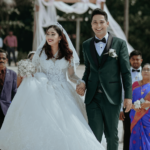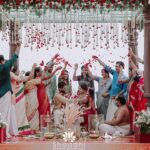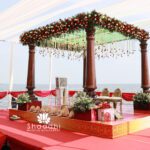While most weddings in the country take with a lot of pomp and splendour, Maharashtrian weddings are not quite so. They are classically simple, traditional and cheerful in themselves. It’s all about finding joy in the little things! We had an amazing experience of one of the Maharashtrian style wedding of Bharat &Bagyashree. We are delighted to share the MaharashtrianWedding Rituals & their customswith you.
Matchmaking And Horoscope (Lagnaach Bedior)
The first step of a traditional Maharashtrian marriage procedure starts with LagnaachBedior finding a suitable match. Once that is accomplished, the horoscopes or patrikas of the boy and the girl are matched by the family priests. After the horoscopes match, the various processes leading up to the wedding begins.
PRE WEDDING RITUALS
Sakhar Puda
SakharPuda is one of the first Rituals heralding the beginning of the wedding process. It is sort of the formal engagement ceremony. It is generally held a few days before the wedding. The two families gather and the bride is given a saree, jewelry and a packet of sugar or SakharPuda by the groom’s mother as a sign of her acceptance to the family.
Muhurt Karane
The precise date and time of the wedding is decided by the family priest and the wedding preparations start at both houses by the inviting five married women or ‘Suhasanie’ to participate on a pre-determined auspicious day certain months before the wedding. In an iron pestle tied with mango leaves, the women pound turmeric or halkund to be used later. They roll out papads and make sandage (pulses soaked and ground, mixed with spices and dried in the sun). After this Rituals the shopping starts and the bride’s side often hold a rukhvat – exhibition of decorative and food items made by the bride.
Wedding Invitations
The wedding invitations are selected and printed for both sides generally months or weeks before the designated wedding date. The first wedding invitation is always presented to Lord Ganesha as a symbolic request for him to grace the auspicious day with his divine presence.
Kelvan
A couple of days before the wedding, a puja is offered to the family deity by both the bride and groom’s side with their respective relatives and friends in attendance. This is known as the Kelvan and is generally followed by a meal.
Halad Chadavane
This particular ceremony takes place on the day before the wedding. The turmeric pound during the MuhurtKarane Ritual is used by the same five Suhasinis. They apply the turmeric paste on the head, shoulders, hands and feet of the bride as well as the groom with mango leaves. The ceremony takes place in the groom’s place first, and then the leftover turmeric paste is sent to the bride’s place where it is applied on her.
Wedding Attires
The Maharashtrian groom traditionally wears an understated white or beige cotton kurta paired with a white Kanche or Dhoti with a thin border for the wedding. They take a decorative piece of cloth on their shoulders generally red or gold in color. They may wear a turban known as pheta on their head or wear the traditional white Gandhi style cap.
The bride wears silk saree with elaborate gold borders in bright colors in typical Maharashtrian trouser like style. The preferred color combinations are yellow or marigold with green or purple borders. The saree can either be Paithani measuring around 6 yards or they can be very Traditional Nauvarisarees measuring 9 yards. The Maharshtrian bride wears some typical jewelry elements – like green glass bangles or Choodas, mangalsutras with two hollow gold cups at the centers, Thusi or traditional necklaces, the typical Maharshtriannath and Vaaki or armlets. The typically Maharshtrian moon-shaped bindi is placed on her forhead.
Both the bride and the groom wear a unisex headband known as ‘Mundavalya’. It is generally two strings of pearls tied horizontally across the forehead and two lines of pears hang down from the headband in front of the ears.
WEDDING RITUALS
Ganpati Puja
The wedding day begins with worshipping Lord Ganesha and asking for his blessing for the couple’s future and that their lives are devoid of any obstacle.
Devdevak
The family deity or KulDevata is then invoked at the site where the wedding is to take place
Gurihar Puja
The bride is decked up in traditional wedding attire, usually gifted to her by the maternal uncle, and she offers her worship to a silver idol of Goddess Parvati placed on a mound of rice. She offers some of the rice to the Goddess and asks for her blessing for a prosperous life.
Punyahvachan
The bride’s parents then accompany their daughter to ask everyone present at the venue to bless their daughter.
Seeman Puja
The groom and his family arrives at the wedding venue and the bride’s mother washes the groom’s feet, applies tilak on his forhead, does his arti and feeds him with sweets.
Antarpat Ritual
The groom now appears at the mandap with his head covered by a traditional cap or turban; he wears the mundavalya and sits at his designated place on the mandap. A cloth is held in front of the groom preventing him to see the bride and this cloth is known as the Antarpat.
Simant Pujan Ritual
Simant literally means boundary. The groom and the marriage party are welcomed at the boundary of the bride`s home or village and her mother does puja of the groom. These days, it is done on the wedding day itself at the place of marriage. Bride’s mother washes the groom’s feet by pouring a little water over his feet in a plate, does kumkumtilak, puts akshata on groom’s head, does arati and gives some sweet. The groom is made to sit in the place and bride’s father gives gifts like a piece of clothing and jewellery to the groom. Groom`s mother and ladies go to bride’s quarter and give her five saris and jewellery.
Sankalp Ritual
The priest chants the Mangalashtakas, or holy wedding vows. The bride is led to the mandap by her maternal uncle. The Antarpat is removed and the couple sees each other. They exchange the garlands and are showered with akshatas or unbroken rice.
Lagna Muhurt
Everybody present in the mandap is given akshata and everybody stands close to the mandap. The groom, head covered with topi and mundavalya tied on the forehead, is invited to the mandap where he stands on a wooden platform (pat) facing west and holding a thick garland. The priests hold a cloth screen called antarpat in front of the groom chanting mangalashtaka. The bride`s maternal uncle escorts the bride to the mandap and she is asked to stand on the other side of the antarpat also holding similar garland. Respective karvali stands behind the bride/groom with a copper kalash containing holy water and topped with betel leaves and coconut. Another young girl stands with arati. Mostly the bridegroom’s mother stands behind the bride with eksari – black beads string with big gold bead in the centre. The bride’s mother is supposed to be absent at this ceremony. She would be waiting at the bride’s quarter where she will not be able to hear the mangalashtaka.
Willing relatives, friends and guests also get chance to sing their own compositions of mangalashtaka which are typical Sanskrit or Marathi verses invoking Gods, describing the ceremony, admiring the bridal couple`s family members, giving advice to the bridal couple and finally giving blessing as also best wishes for the life together ahead. Each stanza ends with “KuryatSadaMangalam, ShubhMangalSavdhan” and everybody showering akshata on the bridal couple.
At the stroke of the muhurt, the priest chants last verses of the mangalashtaka loudly removing the antarpat and among the traditional music of vajantri (consists of shehnai and choughada). The groom first puts a garland around the bride’s neck and then the bride around the groom’s neck. The respective karvalis apply holy water from the kalash to the eyes of bride and groom and perform arati.
Kanyadan Ritual
The father of the bride then gives his daughter away to the groom along with his blessings for them to start a life of Dharma, Artha and Kama. The groom accepts his blessings and says he is receiving love in exchange of love, and that the bride is the Divine love that is showered from the Sky and received on Earth. The bride asks him to promise that he will love and respect her. The bride’s parents perform worship of the couple as avatars of Lord Vishnu and Goddess Lakshmi. The couple ties a piece of turmeric or halkund with a thread on each other’s hands and the Ritual is known as Kankan bandhane. The groom then seals the Ritual by placing the mangalsutra around her neck and applying vermillion on her center parting. The bride in return applies a sandalwood tilak on the groom’s forehead.
Akshataropan
The wedding couple is asked to hold akshata in left hand and shower them with the right while expressing their desire for gunsamriddhi, dhan, dharma, santan, kirti. The priest and elders pray that all their desires be fulfilled.
Mangalsutrabandhan
Continuous Chanting mantras during the ritual when the groom puts mangalsutra around bride`s neck.
Vivah Hom
A stone is kept to the west of the homkund (fire) and a pot of water is kept to its northeast. To the north, four darbhas are spread on which there are two vessels. A pot of Ghee is kept nearby. The priest tells the bridal couple that having taken the oath of marriage now; the same is to be taken in the witness of the sacred fire. Then the priest asks the groom to pour ghee in the name of Skanda, Prajapati, Agni and Som. The groom prays to the sacred fire asking to make them pure and keep their enemy away; asking for children and their long lives; asking to protect his bride and make her give good progeny whom she would see by living a long life.
Lajahoma
A sacred fire is ignited and the bride offers grains to the fire chanting three mantras repeated by the groom. The fourth mantra, however, is uttered silently only by the bride. After that, the bride’s parents worship the couple as avatars of Vishnu and Laxmi and the couple then tie a turmeric thread on each other’s hands. As a final touch, the groom ties the Mangalsutra around the bride’s neck and puts vermillion on her forehead.
Satapadhi Ritual
The couple circumambulate around the sacred fire seven times saying out loud the seven Ritualistic weddings vows.
Karmasampati Ritual
At the end of all wedding Ritual the couple prays in front to the holy fire before it is extinguished. The father of the bride playfully twists the groom’s ear to remind him of his future duties. The couple gets up from the mandap and seeks blessings from all relatives present.
POST WEDDING RITUALS
Varat
The ultimate emotional scene of the whole ceremony is when the bride is bid a goodbye. The groom picks up the silver idol of parvati that is still sitting on gaurihar. The couple touches the feet of elders and the bride meets with all family members to bid a farewell. The couple sits in a vehicle and the procession, with a band and fireworks, goes to the groom’s place.
Grihpravesh
The couple comes to the doorstep and the groom`s mother does arati of the couple. The bride topples a measuring container filled with rice. It signifies that this bride will bring so much luck that prosperity will flow in the house like the rice flowing out of the toppled vessel. The couple sits and the groom places the silver idol of Parvati that he carried and places it in a plate of rice and writes the bride`s new name. The groom`s mother sits between the couple and sees the bride`s face in the mirror – this is called soonmukhbaghane. The couple gives sugar to all present and they have to take names in verses several times.
Manpan:
The bride’s mother does otibharane and gives saris to the groom’s mother, sisters/sister-in-laws. Bride`s father gives gifts to the groom`s father and brothers/brother-in-laws. Similarly, groom`s parents give gifts to the bride`s family.
Reception
The final celebration party is organised where the bride and the groom are introduced to all the guests. The bride wears a saree that is gifted to her by the groom’s family and the groom wears an outfit that the bride’s parents gift him.
Simple yet graceful vibrant yet elegant – a Maharashtrian wedding has flavours of culture, traditions as well as fun and playfulness.
Next day ceremonies of the marriage
Tond Dhune
Tonddhune, the bride`s mother gives a sari and a jewellery piece usually made of pearl to the groom`s mother along with a tea-set.
Vyahi Bhet
Vyahibhet, bride`s father gives a gift made of silver to the groom`s father.
Halad Utaravane
Next day morning, five suvasinis do the same as haladchadhavane but in reverse order. This is to signify that now the couple is free to go out. The groom mother unties kankan – halkund tied on the couple`s hand.
Tikhati Mejwani
Among non-vegetarian Maharashtrians, a non-vegeterian feast is organised at both the quarters separately for the close relatives within a day or two.
This is the last Wedding Rituals in Maharashtrian Wedding.







